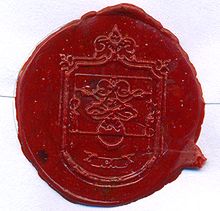Sealing wax

Sealing wax is a paste based on rosin, shellac and turpentine, as well as vermilion or another mineral color. It melts easily, given its low melting temperature, and is used in letters, packages, etc., to guarantee their closure. It is usually red in color.
Sealing wax was used to seal letters between the 16th and 17th centuries. It was also used to take the impression of seals on important documents, or to create an airtight seal on containers. Now it is mainly used for decorative purposes.

Although the exact recipes vary, in general the sealing waxes can be divided into those used before and after the opening of trade with the Indies. In the Middle Ages, sealing wax was generally made from melted beeswax together with Venetian turpentine, a yellow-green resin (extract from the larch tree). The first wax seals were colorless; Later they were often made of wax dyed red with cinnabar. As time passed, in the same century XVI a mixture of different proportions of shellac, turpentine, resin, gypsum was made or chalk and dyes (often still cinnabar, red, or lead), but not real wax.
It was also used to seal wine bottles and preserves. Originally the closure was made of red wax, but later it could also be black (tinted with a black lamp or black ivory) or green (tinted with verdigris). Some users, such as the British Crown, assigned different colors to different types of documents. Today a range of synthetic colors are available.
Sealing wax is normally available in stick form, as granules or as cylinders for use in a gun. The stick is melted at one end, or the granules are heated in a spoon, usually by a flame, and then placed, usually on the flap of an envelope. When the wax is still soft, it is impressed with a seal, often metal, with a design. When it cools it becomes rigid, so when it breaks, it shows that the letter or package has been opened.
Did you mean:Hay velas de lacre tradicionales que siguen produciendo en Canadá, Francia, España, Italia y Escocia, con la misma receta, moldes y técnica de más de 300 años.
Synthetic sealing wax is used industrially to seal the mouths of capsule-like bottles. This sealing wax is easily cut with a knife and comes off without breaking thanks to its flexibility.
To use the sealing gun, simply plug it into the electrical outlet, insert the sealing cylinder and wait for it to heat up. Then with the trigger the sealing wax is applied to the documents. The method is economical and is used for both sporadic and serial sealing, such as wedding invitations.

In the modern world, wax sealing has brought endless applications, in most cases in decorative form. Since the advent of the postal system, the use of sealing wax has become more than security but a fine detail for a special event. Modern times have demanded new styles and the creation of synthetic sealing wax, allowing the package to be manipulated without affecting or breaking the seal. These new waxes are flexible for shipping and can be applied using a sealing wax glue gun, sealing wax imitations, or flexible wax, allowing for more handling, but without affecting or breaking the seal.
The majority of European noble families, as well as some families in America, continue to use sealing wax to give a certain presence to a document, a seal that is generally the family's heraldic shield.
Contenido relacionado
Masaccio
PIP
Executive